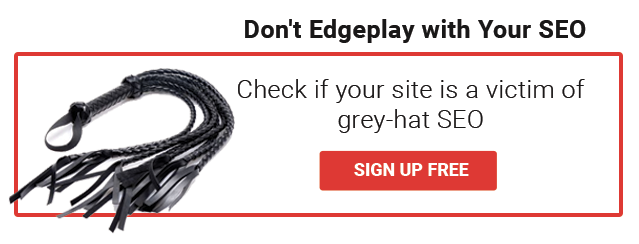
Once you’ve enjoyed the results of your white-hat SEO experiments, there is a risk of going a little bit further… like using edgeplay techniques.
Where does Google draw the line between what deserves to rank high and what doesn’t? This decision isn’t entirely up to Google; it’s the judge, but users are the jury. Their relationship with a site decides where it belongs.
- If users like a site, keep visiting it and recommend it to others of their own volition, Google understands this site deserves acknowledgment. In this scenario, you can be sure the site was optimized with white hat SEO.
- On the other hand, a site may break through despite failing to satisfy users and even causing complaints. When this happens, there’s a chance the site’s owner has been using shady methods capable of gaming the ranking algorithm. This is called black hat SEO. To avoid these techniques and keep your SEO strategy clean, consider utilizing WebCEO’s SEO Content Assistant for optimizing your content effectively.
- Naturally, there’s a middle ground as well: gaming the algorithm via questionable methods that don’t offend users. That’s grey hat SEO. Such methods are still pretty risky because you never know when Google will decide to crack down on them.
Google has been around long enough to collect feedback from billions of users and turn it into a set of guidelines. The process of evaluating sites is almost completely automated. Your site might receive no actual complaints from users and still get penalized for doing something wrong. This shows how important it is to know the difference between white, black and grey hat SEO techniques. To ensure your backlink profile is clean and penalty-free, WebCEO’s Backlink Checker can be an invaluable tool.
Let’s peer through all the shades of grey and black. Read these webmaster anti-guidelines and stay on the path of white hat.
1. Keyword stuffing in the text: writing sentences or even entire paragraphs made mostly of search queries.
2. Keyword stuffing in ALT tags: using those tags to game SEO instead of their actual purpose (writing descriptions which can be used as alternatives to images when they can’t be viewed or displayed).
3. Keyword stuffing in anchor texts: using overly keyword-rich anchor texts in links for the sake of raising the rankings of linked pages.
4. Keyword stuffing in domain names: registering a domain name made of multiple keywords.
5. Spammy anchor text profile: using commercial keywords (e.g. best SEO tools, free SEO tools) in the anchor texts of most or all backlinks.
6. Same anchor text in all backlinks: attempting to make a site rank for a keyword by using it in most or all backlinks.
7. Exact match anchor text: creating internal and external links with anchor texts matching the URL slug of the links.
8. Content swapping: trying to make pages rank for keywords that are unrelated to their actual content.
9. Hidden content: making text or links on a page invisible to the human eye (very small qualifies, too).
10. Using multiple H1 tags on a page: it’s best to use either one H1 header or none at all (using none is not recommended, unless it’s a non-essential page you don’t need to rank).
11. Duplicate content: pages with plagiarized text will be deemed less relevant than the original.
12. Mirror site: an extreme case of duplicate content where a domain is copied in its entirety.
13. Automated content creation: filling your site with content generated with automated software or services.
14. Article spinning: attempting to avoid duplicate content-related issues by rewriting someone else’s content (either manually or automatically).
15. Cloaking: displaying different versions of the same page to humans and search engine bots.
16. False content: writing content that contains factually incorrect information.
17. Malicious content: writing content that tricks or outright goads users into hurting themselves and others.
18. Poorly formatted content: pages containing grammar errors, misspelled words or gibberish, text colored or sized in a disorderly manner, too big or otherwise distracting images.
19. Excessive internal links: placing more internal links to the same pages than needed in order to increase the likelihood of users visiting them.
20. Excessive links in the footer: overloading the footer with links to other sites.
21. Clickbait: giving your pages deceptive, offensive or otherwise provoking titles and headlines.
22. Link exchange: aggressive linking between two or more sites for the sake of building a large link profile.
23. Spam in blog comments: putting spammy links to your domain in another site’s comment section.
24. Guest blog spam: writing guest blog articles with spammy links (or spammy articles to begin with).
25. Spam in social media: making posts and comments with spammy links to your site on social platforms.
26. Buying positive reviews: obtaining positive customer reviews in exchange for a reward (money, products or services).
27. Buying links: obtaining dofollow backlinks from a domain in exchange for a reward (in reality, Google is fine with people paying seemingly legit public relations firms and valid directories for content/listings).
28. Selling links: placing authority-passing links to another domain on your own site in exchange for a reward.
29. Building toxic links: obtaining backlinks from low-quality, unauthoritative domains.
30. Low-authority directory listings: submitting your website to and obtaining backlinks from directories of low quality and authority.
31. Link farming: submitting your site to link farms (websites whose content is mostly links to other domains) or turning your own site into one.
32. Negative SEO: hurting your competitors’ reputation with Google through underhanded means such as submitting false reports against their websites, or building links to them from low-quality and pornographic sites.
33. Content scraping: using software and scripts to steal pieces of content (such as, but not limited to copyrighted content and database information) from other sites.
34. Unethical redirects: rigging elements on a page to open unrelated pages in order to direct traffic there.
35. Doorway pages: baiting users with well-optimized, high-ranking pages which automatically redirect them to unrelated pages.
36. Parasite hosting: planting your page on another domain in order to take advantage of its authority and resources.
37. Domain grabbing: buying expired high-authority domains to build backlinks from them.
38. SEO squatting: a grey hat version of domain grabbing where one buys expired domains only to bypass the process of building their authority from scratch.
39. Google bombing: making a page rank for an unrelated keyword by creating a large number of backlinks with anchor texts containing that keyword (example: in 2013, the query “miserable failure” was made to show web pages on George Bush).
40. Cybersquatting: registering a domain under the name of a known brand without belonging to said brand for the purpose of stealing their traffic or reselling it to them.
41. Typosquatting: registering a domain under a name which is a misspelled version of a known brand’s name without belonging to said brand.
42. Rich snippet markup spam: creating rich snippets with fake information in an attempt to increase a page’s click-through rate.
43. Google Maps spamming: registering fake business listings on Google Maps.
44. Private blog networks: creating a multitude of blogs to accumulate authority and pass it to the main domain.
45. Bait and switch: making an ordinary page rank high and then changing its content to commercial.
46. Sponsored content: paid guest articles containing authority-passing backlinks.
47. Trackback spam: using the TrackBack feature on blogging platforms to send other users notifications with backlinks to your own site.
48. Automated Google queries: using software to generate automated searches for specific keywords in order to make your site rank higher for them.
49. Referrer spam: using fake referrer URLs to send requests to other sites, which leads to said URLs being recorded in the targeted sites’ statistics and crawled by search engines as backlinks.
50. Illegal content: filling pages with types of content prohibited by law.




